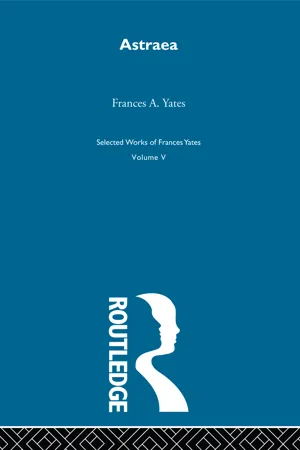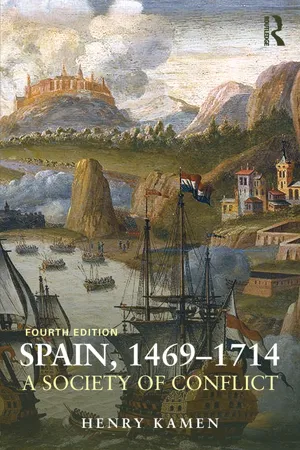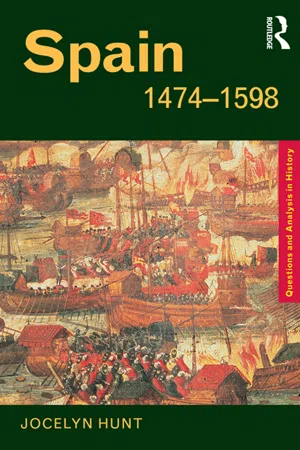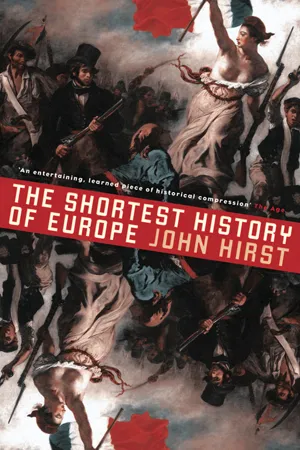Charles V Holy Roman Emperor
Charles V, Holy Roman Emperor, was a powerful ruler who reigned from 1519 to 1556. He inherited a vast empire that included Spain, the Netherlands, and parts of Italy, and also expanded his influence through conquests in the Americas. Charles V was a key figure in the religious and political conflicts of the Reformation era, and his reign marked a period of significant European expansion and change.
6 Key excerpts on "Charles V Holy Roman Emperor"
- eBook - ePub
- William Maltby(Author)
- 2008(Publication Date)
- Bloomsbury Academic(Publisher)
...By this time Chièvres had died. Charles then showed that, left to his own devices, he could be a masterful politician. His settlement of the revolt balanced conciliation with judicial force, and from that time forward Castile became the most loyal of his kingdoms. The concerns of the rebels, however, had been justified. The inheritance of Charles V, as he is now called out of deference to the imperial title, drew the Spanish kingdoms into a host of entanglements on the continent of Europe. THE EUROPEAN EMPIRE OF CHARLES V Charles now ruled the Netherlands, Spain, the Aragonese kingdoms in Italy, and the German Empire. The union of these polities was, and would remain, entirely personal until his death. Their individual constitutions, and Charles’s place within them, varied enormously, as did their ability to generate revenues for projects beyond their own immediate needs. The European empire of Charles V was not, in other words, a Spanish empire in the constitutional sense, but by the end of his reign Spain would become the dominant power within it. A brief description of the empire’s major components suggests the reasons for this development. The Holy Roman Empire, from which Charles derived his imperial title, was not a kingdom, but a federation of more than 200 princely states and free cities, most of whom pursued their own policies with little regard for the emperor. The larger principalities resembled the monarchies of Western Europe with their own chanceries and representative institutions. Some of the lesser princes survived by acting as military contractors, selling their service to the highest bidders. More than 80 imperial cities had achieved virtual self-government in the period of imperial disintegration after 1250, and many possessed their own militias. In theory, the emperor was supposed to determine foreign policy and serve as the empire’s military leader...
- eBook - ePub
- Frances A. Yates(Author)
- 2013(Publication Date)
- Routledge(Publisher)
...PART I CHARLES V AND THE IDEA OF THE EMPIRE In the middle of the sixteenth century, the Holy Roman Empire, which had seemed to be dwindling more and more rapidly into a local German concern, suddenly takes on once more something of its old significance. The century in which a new Europe, with its great states built up on principles of realistic statecraft and infused with national patriotism, was in process of formation saw also a late manifestation of the Monarch, the potential Lord of the World, in the person of the Emperor Charles V. The patterns of the new Europe take their shape under the shadow, or the mirage, of a recrudescence of the idea of the Empire. The revival of imperialism in Charles V was a phantom revival. That he looked so much like a Lord of the World was due to the Hapsburg dynastic marriage policy which had brought such vast territories under his rule, and when, after his death, Phillip II succeeded to the Spanish monarchy whilst the imperial title passed to another branch of the Hapsburg family, the whole imposing edifice of the empire of the second Charlemagne broke down. The transitory and unreal character of the empire of Charles V is the aspect of it usually stressed by modern historians. Whilst not denying its unreality in the political sense, it is the purpose of the present essay to suggest that it is precisely as a phantom that Charles’s empire was of importance, because it raised again the imperial idea and spread it through Europe in the symbolism of its propaganda, and that at a time when the more advanced political thinking was discrediting it. The following attempt to place the empire of Charles V in a historical context is obviously no more than a slight sketch, or a partial evocation of a vast subject. It is not concerned with political realities, nor with straight political history, but with the idea of empire, or the imperialist hope. As Folz has said, ‘A la différence de la notion politique de l’Empire. . ...
- eBook - ePub
Spain, 1469-1714
A Society of Conflict
- Henry Kamen(Author)
- 2014(Publication Date)
- Routledge(Publisher)
...No political links held his diverse territories together; all they shared was a common loyalty to him as ruler. He was in reality ‘emperor’ only of the lands included in the Holy Roman Empire: elsewhere he ruled individual territories as king, or duke, or count. Even in Germany the title of emperor gave only limited authority. Charles’s power rested more securely on the hereditary Habsburg lands in the east, and the provinces (the Netherlands, Franche-Comté) that made up the Burgundian inheritance, to which he was deeply attached and treated almost as a family holding. Because all these territories had no common institutions, Charles was forced to improvise. The one great obligation on him, to rule personally in each of his dominions, was of course impossible to fulfil; and he appointed regents or viceroys from members of his family. In order to have a central consultative body Charles appointed dignitaries from several parts of the monarchy to his Council of State, a largely honorific body that by 1526 was composed mostly of Spaniards. In practice Charles himself coordinated business, with the help of advisers and a small secretariat. Chièvres at first, and then Gattinara until his death in 1530, dominated his counsels. The highly efficient work of Cobos, who enjoyed the title of Secretary of State and was answerable for Spain, Italy and the Indies, pointed the way to a regional division of responsibilities. When Nicholas Perrenot de Granvelle (d. 1550) replaced Gattinara, he was accordingly put in charge of affairs in northern Europe, where the paperwork was done in the French language. The Venetian ambassador concluded in 1546 that ‘the emperor has two principal counsellors, Cobos and Granvelle, who transact all the business of all his states’; but this underestimates the enormous personal labour of Charles in the field of diplomacy and above all in war...
- eBook - ePub
- Jocelyn Hunt(Author)
- 2015(Publication Date)
- Routledge(Publisher)
...5 FOREIGN AFFAIRS DURING THE REIGN OF CHARLES I BACKGROUND NARRATIVE Charles I’s inheritance ensured that he would need to spend much time, money and effort on issues outside Spain. As Ferdinand’s heir, he confronted France, both in the Pyrenees and in Italy. His duchy of Burgundy included lands which were claimed by France and conversely, as Duke, he needed to repossess the provinces which France had taken over. As heir to Maximilian von Habsburg, the lands of south-eastern Europe were his concern and, once elected Holy Roman Emperor in 1519, the states of Germany became his responsibility too. As far as the Spanish were concerned, time spent ruling his other kingdoms was time spent on and in foreign lands; but, for Charles, all parts of his empire were equally his, and while he never strove to unite them he nevertheless treated them all as part of a family of which he was the head. Relations with Portugal were much more settled than they had been during the reigns of the Catholic monarchs. The marriage of Isabella to Charles led to fifty settled years, during which rivalries were played out in the Atlantic and the Americas, rather than on the Iberian peninsula. John III (1521–57) married Charles’ sister Catherine and was persuaded to adopt the same religious policies as Spain, and to expel his Jews and Muslims. By the end of Charles’ reign it had become clear that the death of John’s son, which left his infant grandson heir to the throne of Portugal, would provide new opportunities for a Castilian takeover. The war against France lasted throughout Charles’ reign, draining Spanish resources and manpower. Although Chièvres had tried to ensure friendship, he could not overcome the many causes for hostility between France and the Habsburg Emperor. In 1521 French attacks on Navarre and Luxembourg ended the brief period of peace which had followed the 1516 Treaty of Noyon, and enabled Charles to gain and keep Tournai...
- eBook - ePub
- Carter Lindberg(Author)
- 2020(Publication Date)
- Wiley-Blackwell(Publisher)
...Maps Europe about 1500 Germany at the time of the Reformations The Empire of Charles V The Ottoman Empire The Portuguese and Spanish overseas empires Religious divisions in Europe about 1600...
- eBook - ePub
- John Hirst(Author)
- 2012(Publication Date)
- Black Inc.(Publisher)
...With many changes of boundaries this territory survived as the pope’s until the nineteenth century. It was only then, with the creation of a unified Italian state, that the pope was confined to the pocket-handkerchief kingdom he has today. King Pepin’s son was Charles the Great or Charlemagne. He greatly expanded the territory of the Frankish kingdom. His lands extended across the Pyrenees into Spain; halfway down Italy including the land his father had allotted to the pope; in the east to Austria and well into modern Germany. Since the fall of Rome, there has been no single European state that was so extensive except for the short-lived empires of Hitler and Napoleon. In Germany Charlemagne was dealing with the Saxons, who had not crossed into the Roman Empire. They were pagans; he gave them the option of converting to Christianity or being made into slaves and shipped back to his heartland. The kingdom of the Franks grew to cover modern France and parts of Germany, Spain and Italy. In the year 800 Charlemagne visited Rome and attended mass on Christmas Day in the cathedral. After the mass, and seemingly with no prior warning, the pope placed a crown on Charlemagne’s head and declared him to be Roman emperor. He made his own emperor in order to have a power that would protect him. But since he was turning his back on the emperor in the east, he needed to have an excuse for what he was doing. What could be easier! A woman had become emperor in Constantinople; she had blinded her son, who was the emperor, got rid of him and put herself on the throne. By the pope’s deed, she was no longer emperor over the west. There was later great dispute between popes and emperors about what had happened in the cathedral on Christmas Day 800. Popes emphasised that it was the pope who put the crown on Charlemagne’s head, which indicated that the pope was superior to the emperor. But after the pope put the crown on Charlemagne’s head, he bowed to Charlemagne...





